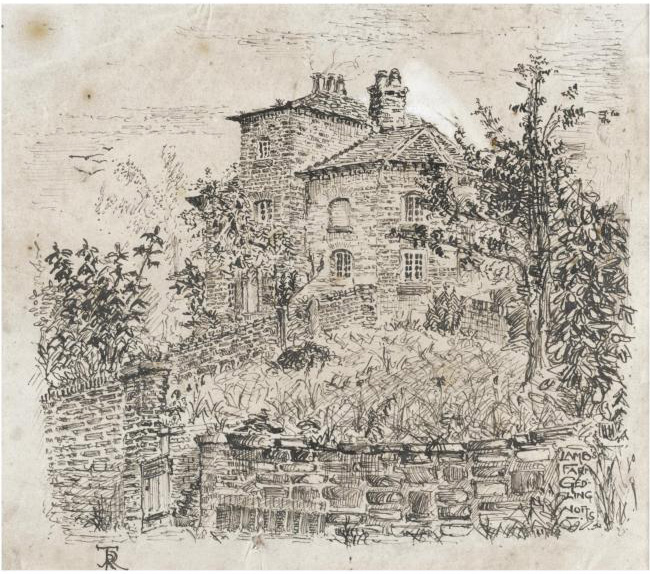
A few years ago, we featured J.R.R. Tolkien’s personal cover designs for the Lord of the Rings trilogy, a series of novels that justifiably made his name as a world-builder in prose (and occasional verse), but rather overshadowed his output as an illustrator. He didn’t just do covers for his own books, either. You can get a sense of the breadth of Tolkien’s visual art at the Tolkien Gateway’s gallery of over 100 images by Tolkien, which reveal the landscapes, letters, interiors, and animals within the creator of Middle-Earth’s mind.

Many of these images come with descriptions of their provenance, which you can read if you click on their thumbnails in the gallery. At the top of the post, you’ll find Tolkien’s 1927 painting Glaurung Sets Forth to Seek Turin, first published in The Silmarillion Calendar 1978.
“The title is in Old English letters, which J. R. R. Tolkien frequently used when writing in a formal style,” says the Tolkien Gateway, noting that, “at the time of the painting the name of the Father of Dragons was Glórund, not Glaurung,” and that “the entrance to Nargothrond is here seen as a single arch, unlike the triple doors seen in other drawings.” (Leave it to a Tolkien fan site to have just this sort of information at the ready.)

We also have here Tolkien’s crayon drawing of the West Gate of the Moria, a scene described in The Fellowship of the Ring as follows: “Beyond the ominous water were reared vast cliffs, their stern faces pallid in the fading light: final and impassable.” Just above is Tolkien’s rendering of Bag-End, residence of a certain B. Baggins, Esquire, “coloured by H.E. Riddett and first published in the English De Luxe edition and in a new edition of the Dutch translation (both 1976) of The Hobbit.” Just below, you can see his 1911 sketch of the much less fantastical Lamb’s Farm, Gedling.

Beyond perusing the images in the Tolkien Gateway, you’ll also want to have a look at Wayne G. Hammond and Christina Scull’s book, J.R.R. Tolkien: Artist and Illustrator. Some Tolkien enthusiasts will, understandably, prefer to keep their personal visualizations of the Lord of the Rings universe unsullied by non-textual imagery such as this, but if all of Peter Jackson’s megabudget film adaptations didn’t sully you, then Tolkien’s mild, almost rustic but still solemnly evocative drawings and paintings can only enrich the Middle-Earth in your own mind.
Related Content:
Discover J.R.R. Tolkien’s Personal Book Cover Designs for The Lord of the Rings Trilogy
The Only Drawing from Maurice Sendak’s Short-Lived Attempt to Illustrate The Hobbit
Hear J.R.R. Tolkien Read From The Lord of the Rings and The Hobbit
Soviet-Era Illustrations Of J. R. R. Tolkien’s The Hobbit (1976)
Colin Marshall writes on cities, language, Asia, and men’s style. He’s at work on a book about Los Angeles, A Los Angeles Primer, and the video series The City in Cinema. Follow him on Twitter at @colinmarshall or on Facebook.



The artwork certainly adds to the classic stories by Tolkien: the Hobbit to the Lord of the Rings and the Silmarillion. The art and the maps help inspire the imagination while reading. Mike M.
No, the Glaurung_sets_forth_to_seek_Turin image was done by JRRT.
Where are the other 106 drawings?
Click on the third hyperlink in the first paragraph under the first picture…
Does anyone know a place to buy a good print of some of this artwork?
can somebody pls. give me infor on or send me a link to valuable Tolkien (paintings / illustrations) copyright issues? Thank you in advance.
netflix keyword
no